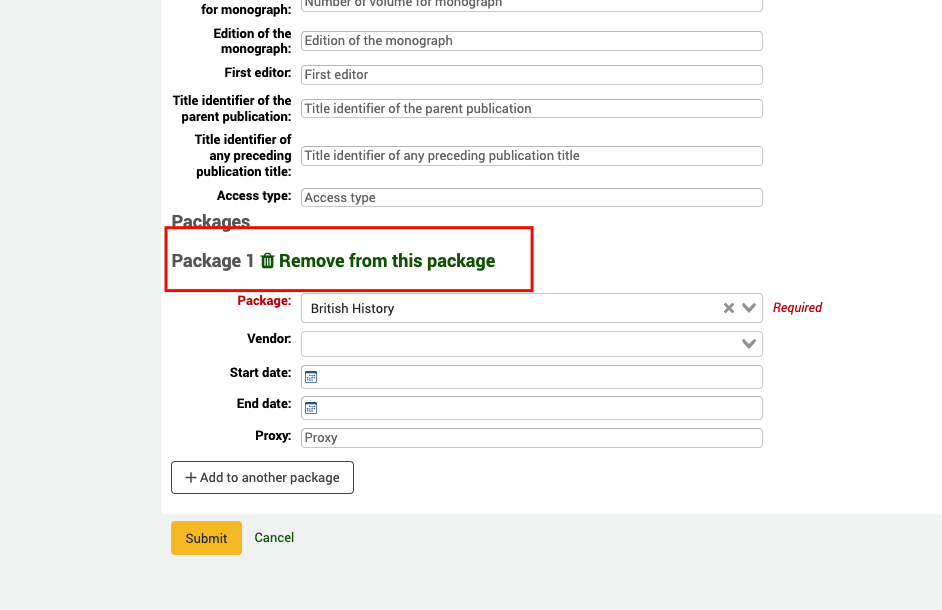eHoldings
Definition of terms:
Resource
A resource is an instance of a title. Consequently a resource would have a separate resource ID for each occurrence of the title in a package.
For example: Teise / Law belongs in
DOAJ
Criminal Justice Abstracts with Full Text
etc.
Knowledge base (KB)
A knowledge base is an extensive database maintained by a knowledge base supplier (for example, EBSCO) that contains information about electronic resources such as title lists and coverage dates, etc. Knowledge bases typically organize the resources provided by a content provider into collections or databases that reflect specific content provider offerings, for example packages of e-journals, e-books, or other materials.
Providers
The provider of the e-resource, for example, the vendor, consortia or publisher.
Packages
A collection of e-resource titles bundled together and distributed by a provider.
Titles
The individual e-resources, for example a journal or e-book, usually contained within a package.
Get there: More > E-resource management
On the left-hand navigation menu, you will see links for each provider you have configured in the ERMProviders system preference.

The integration with the EBSCO global knowledge base is facilitated via their HoldingsIQ tool. This is a bidirectional API that allows you to update or read from EBSCO’s knowledge base of millions of titles. Your instance of the EBSCO knowledge base becomes searchable and manageable via Koha using your Customer ID in the configuration. Remember, the knowledge base always sits at EBSCO, you are just manipulating it through Koha in the same way you would if you were using EBSCOadmin. No content data is held locally in your Koha system.
PackagesGet there: More > E-resource management > EBSCO > Packages
On the Package home screen you will see a search box

Koha acts as a “proxy” for the EBSCO HoldingsIQ service so any search you do here is done in real time against the EBSCO knowledge base (using your Customer ID in the ERMProviderEbscoCustomerID system preference). There are two filters:
Content type: This filter is provided by EBSCO as part of their HoldingsIQ API and allows you to narrow down your search to a particular content type (as defined by EBSCO).
Select status: This filter is provided by EBSCO as part of their HoldingsIQ API and allows you to narrow down your search to material that you may already have added to your holdings through EBSCOadmin. So, for example, you can search for packages that you have already subscribed to.
Any package which is already selected is indicated by a check mark on the right-hand side of the title.

In brackets you can see the EBSCO package ID.
When you click on a package link, you will be taken to the full view of the package.
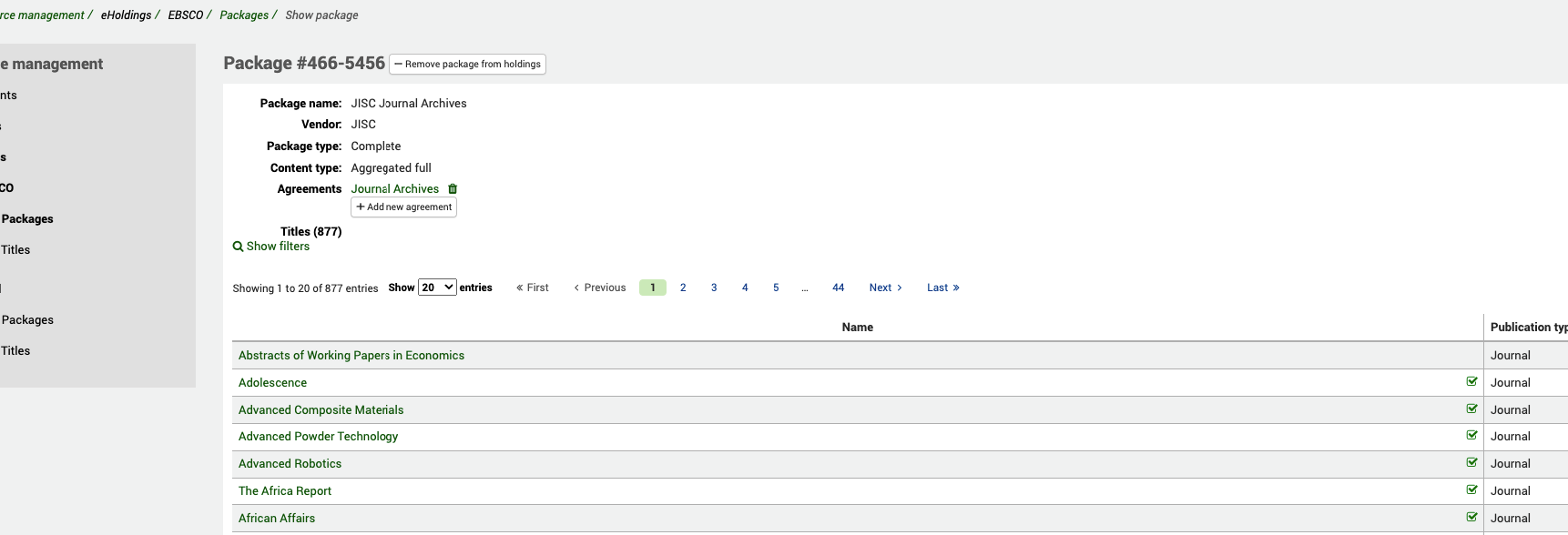
Some information displayed here is brought through from the HoldingsIQ API, you can see the Vendor (this is NOT the Koha vendor), the Content type and the Package type. You can also see from this screen that the package contains (in this case) 877 titles. As with the package list, you can see from here (by the check marks) which titles have been selected and which not.
Clicking on the Show filters link will give you some additional filters to allow you to search within the package for a particular title or group of titles. This can be by Publication type, Selection status (titles already selected, or not, in EBSCOadmin) and a title search box.
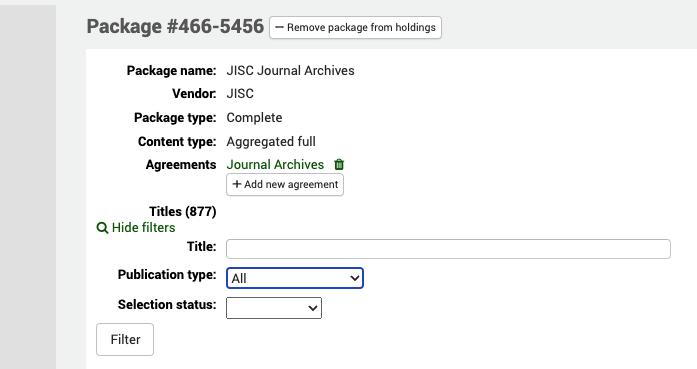
In the example above, you can see that this package has already been added to the existing Agreement record in Koha (called Journal Archives). A package can be added to multiple Agreement records. Clicking the hypertext link will take you to the agreement record.
Once you have made this connection, you will see the package listed on the agreement record.

To add to a new package, click on the ‘Add new agreement’ button and you will be taken to a dialogue box with a list of agreements that can be filtered. Use the Select button to make the connection between the two records.

Use the ‘Delete’ icon to remove a package from an agreement.
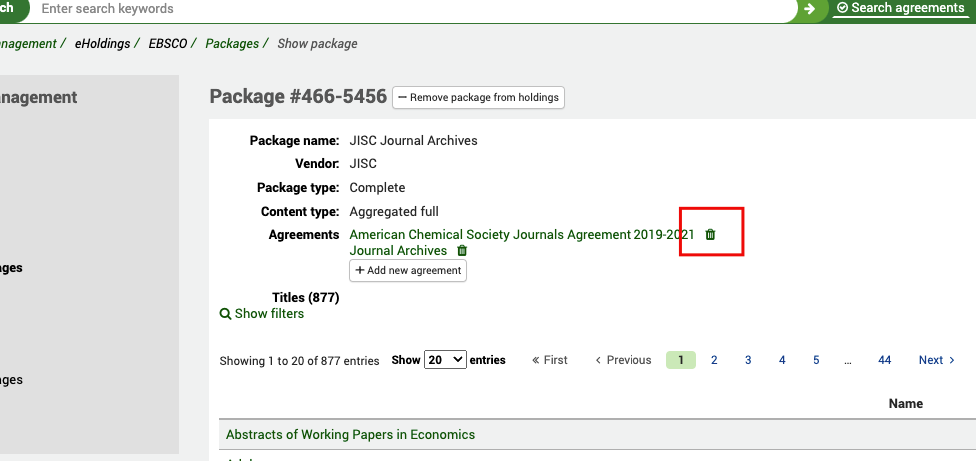
If you try to add a package to the same agreement more than once, you will receive the following error message:

From the package view, you are also able to add or remove a complete package from your EBSCO holdings.

This makes an API call via the HoldingsIQ service to add or remove the package from your EBSCO central holdings. Because this is a real-time call you should see your holdings updated in EBSCOadmin as well.
You can also click on a title link here and go into the detail of a specific title in a package.

The Resource # you can see at the top of the screen is the EBSCO resource ID. The metadata you see is also returned by the HoldingsIQ API from the EBSCO knowledge base. You can see the Publication title, name, Publication type, and print/online IDs and the coverage dates. Remember the coverage dates of a title may be different depending on the package that the title is included in. You can also see both the Vendor and the Package (which is a hypertext link back to the full package you have come from).
Add/remove title from packageYou can add or remove a title from a package you are subscribed to.
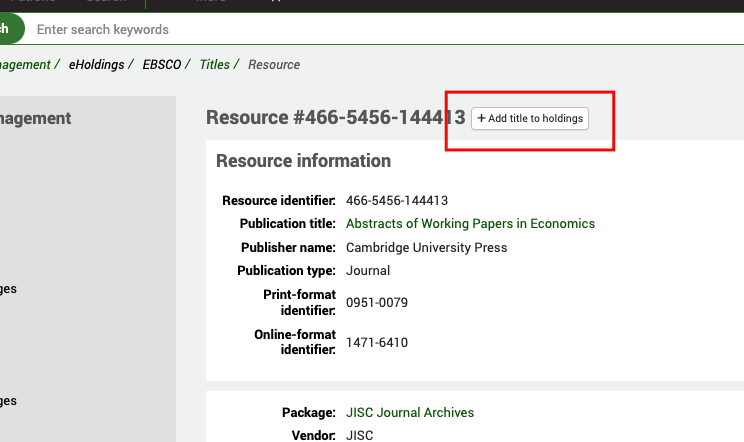
Although you may subscribe to a complete package, there may be individual titles you wish to specifically include/exclude. Use the ‘Add/remove title to holdings’ button to do this.
TitlesGet there: More > E-resource management > EBSCO > Titles
On the Titles home screen, you will see a search box.

Koha acts as a “proxy” for the EBSCO HoldingsIQ service so any search you do here is done in real time against the EBSCO knowledge base (using your Customer ID in the ERMProviderEbscoCustomerID system preference). There are two filters:
Publication type: This filter is provided by EBSCO as part of their HoldingsIQ API and allows you to narrow down your search to a particular publication type (as defined by EBSCO).
Select status: This filter is provided by EBSCO as part of their HoldingsIQ API and allows you to narrow down your search to titles that you may already have added to your holdings through EBSCOadmin. So, for example, you can search for titles that you have already subscribed to.
Any title which is already selected is indicated by a check mark on the right-hand side of the title.

You will also notice that this search also searches for Local titles in addition to EBSCO titles. Any local titles will be indicated above the title list and this is a hypertext link to take you through to the Local titles table.
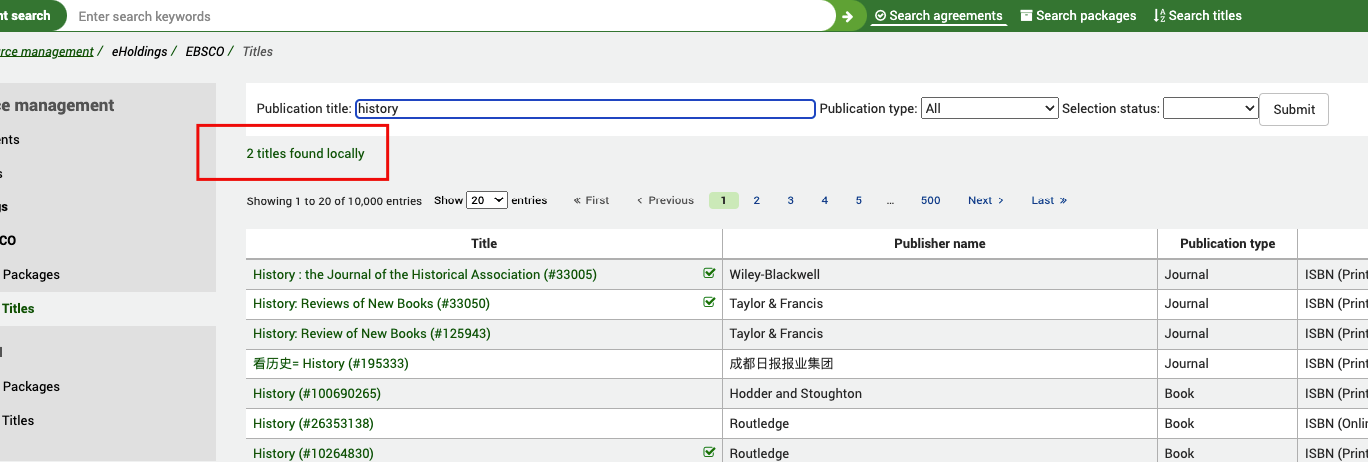
By clicking on a title, you can go into the full record view of it.

At the top you see the Title #. This is the EBSCO title reference. The rest of the metadata all comes from the HoldingsIQ API and includes things like IDs, publishers etc.
You can also see here every Package that this title is contained in. The check mark indicates that you are already subscribed to this package. So, in the example above, we have this title via the ScienceDirect package but not Scholars Portal.
If you click on the Package link, you will see the view of that resource within that package.
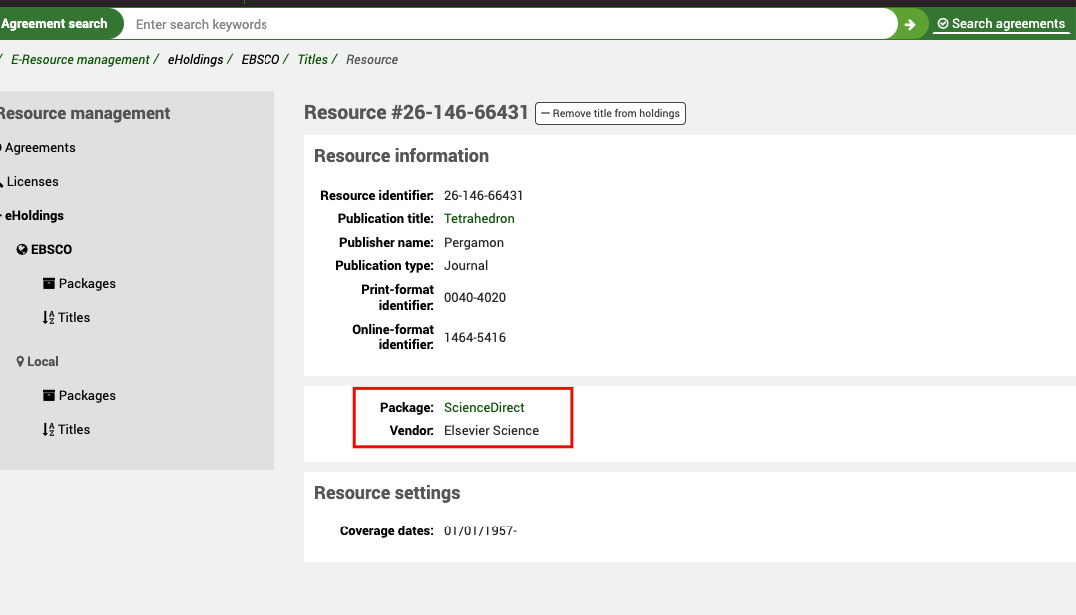
This includes the coverage provided by that provider.
If you want to selectively add or remove that title from your package holdings you can do that from this screen.

You can also see the EBSCO resource ID on this screen. Remember that the resource ID represents the instance of a title within a package.
If you want to go back to the title record, you can click on the Title link.
On the Title page, you are also provided with filters to narrow down your search. You get to this by clicking on the Show/Hide filters link.
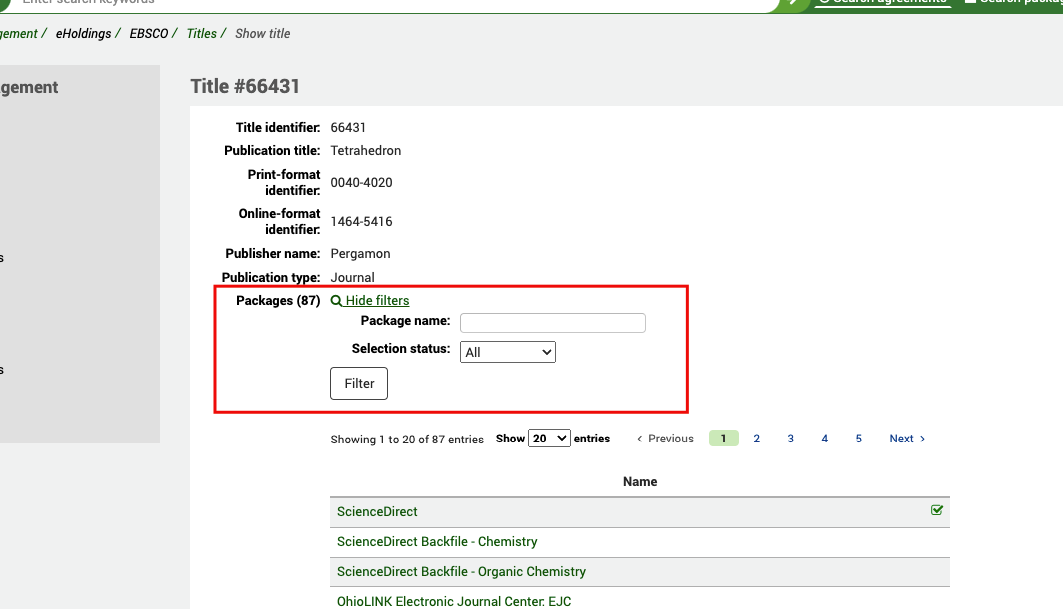
This is useful if you want to narrow down your query to a specific package or to packages that are already selected in your holdings.
LocalLocal holdings are electronic holdings which are not contained in a global knowledge base but, instead (unlike EBSCO holdings) are stored in the local Koha database tables (erm_eholdings_titles).
TitlesGet there: More > E-resource management > eHoldings > Local > Titles
On the Local Titles home screen, you will see a list of currently created local titles.

You can use the table and column filters to narrow down your list to a selected title or group of titles.
Note
You can customize the columns of this table by clicking the ‘Configure’ button. It will take you to the Administration module and specifically to the ‘table id: titles’ section of the Table settings.
By clicking on a title, you can go to the full view of the record.
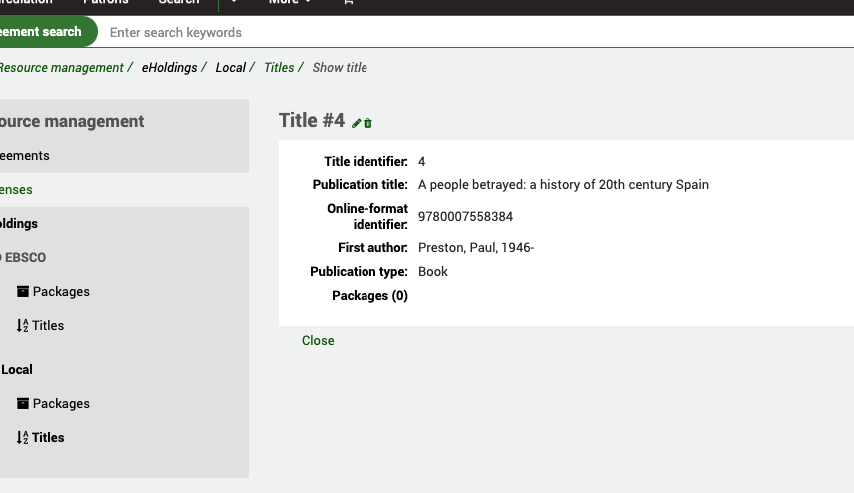
From here you can Edit or Delete the record.
If the record belongs to a locally created package, you will see that information here.

If the title is part of more than one package, you can use the table filters to restrict your search further. Clicking on the Package link will take you through to the package itself.
Create a new local title recordFrom the ERM Home page click on the Titles link in the left-hand menu under Local.
Get there: More > E-resource management > eHoldings > Local > Titles
Use the ‘New Title’ button at the top of the Titles table.

You should see a metadata template. This template is based on KBART metadata.

When you save the title, Koha will also automatically create a bibliographic record for you with as much of the metadata as possible. We map the KBART metadata to MARC21 in the following way:
publication_title = biblio.title
print_identifier = 020$a||020$z||022$a||022$y
online_identifier = 020$a||020$z||022$a||022$y
date_first_issue_online = 866$a (before ‘-‘)
date_last_issue_online = 866$a (after ‘-‘)
num_first_vol_online = 863$a (before ‘-‘)
num_last_vol_online = 863$a (after ‘-‘)
title_url = 856$u
first_author = biblio.first_author
coverage_depth = title_url ? ‘fulltext’ : ‘print’
notes = $852$z
publisher_name = 260$b
When you save the record and look at the full view, you will see a link to the bibliographic record.

At the bottom of the creation/edit template, you will see the option to add the title to a local package.
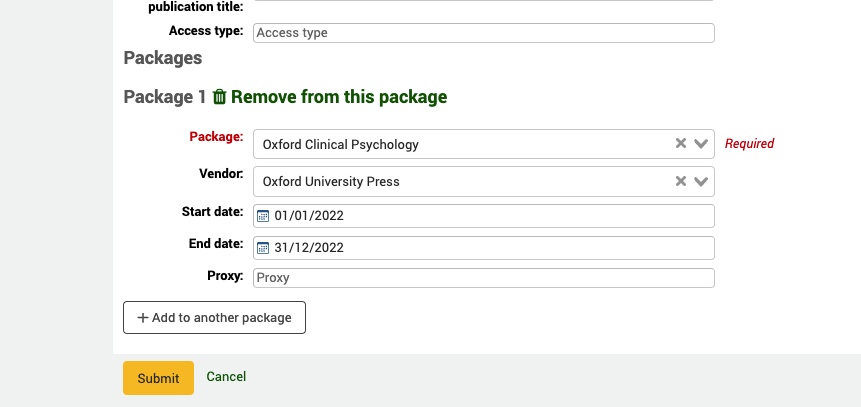
The package record must already exist before you try to link to it from the dropdown menu. You can also specify the Vendor, start and end dates and a reference to a proxy server if one is required for this service (this is not currently used in Koha, for reference only).
A title can belong to multiple packages.
Import a new local title record from a ListIf you want to quickly add multiple title records to your Local holdings, then you have the option to import from a Koha List.
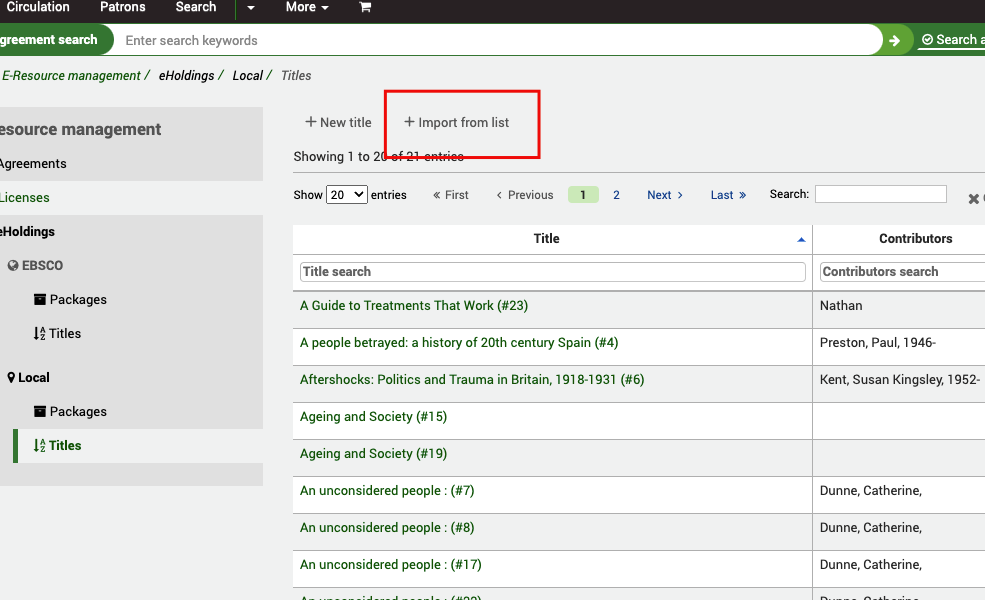
First of all, create a Koha List (as described elsewhere in this manual) and add some bibliographic information to it (either by creating the record manually or by importing it via z39.50 or Stage MARC records). Once the list has been created, you will see it in the table selection.

First select the package you want to add the titles to and then select the list from the selection in the table. Use the Import button to link them together.
You will see a message “import in progress” and the job should be completed in a few moments. You can click on the Job number if you want to view progress.

At this point you should see the titles in both the title list and also attached to your selected package.
Import a new local title record from a KBART fileVersion
This component of ERM was introduced in version 24.05 of Koha.
If you want to quickly add multiple title records to your Local holdings, and your vendor can provide KBART records, then this is a quick way to get eholdings records into Koha.
First of all, create a Local package to attach the title records to.
Get there: More > E-resource management > eHoldings > Local > Packages
Once you have done that, go to your Local titles and use the button marked ‘Import from KBART file’.

From here, use the File button to select a file of KBART files from your local device. Select the Package that you want to attach the titles to and, finally, select whether you want Koha to try and create basic bibliographic records from the data in the KBART file (this is optional).
Once the file is imported it will be sent to the background jobs for processing. You can check Background Jobs for progress but, once completed, the titles will appear in your Local title list.

Some useful resources:
KBART Standard NISO KBART Registry (good source for KBART files) Useful information on KBART format etc.
Note
The imported KBART file should be in TSV or CSV format
Get there: More > E-resource management > eHoldings > Local > Packages
On the Local Package home screen, you will see a list of currently created local packages.

Note
You can customize the columns of this table by clicking the ‘Configure’ button. It will take you to the Administration module and specifically to the ‘table id: packages’ section of the Table settings.
Clicking on a package name will take you through to the full view.
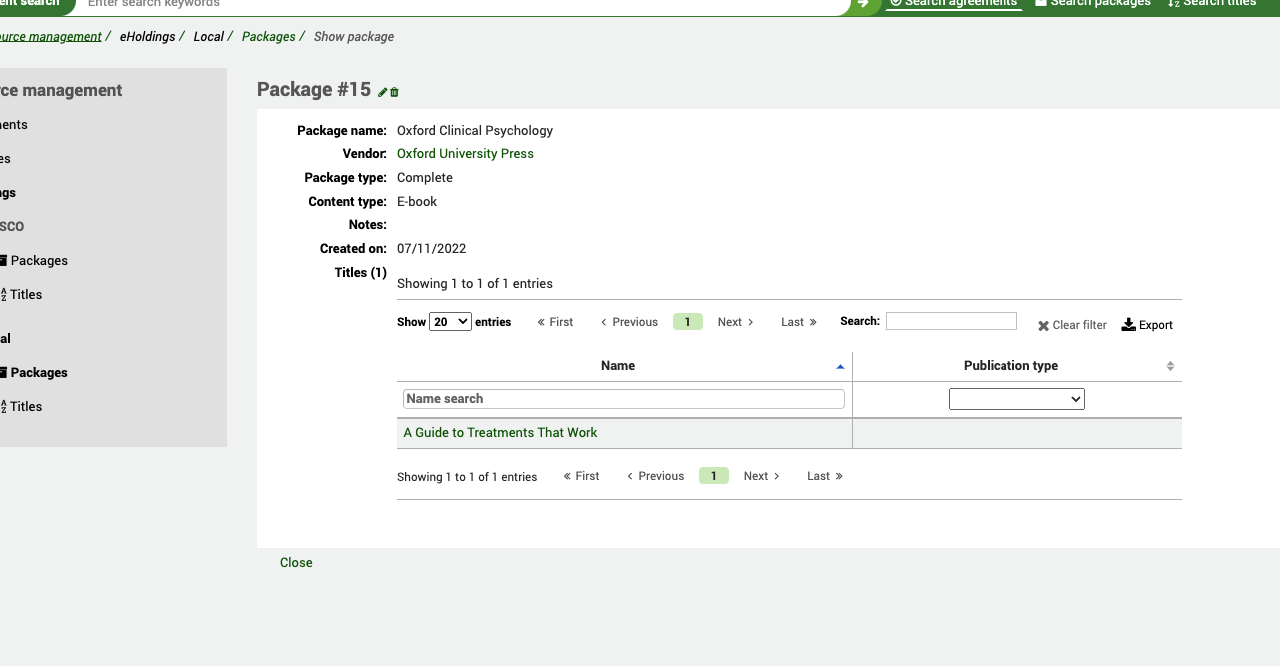
You can use the table filter to narrow down the titles if you need to.
Clicking on the title will take you to the title full view and clicking on the Vendor will take you through to the vendor record in acquisitions.
From this screen you can also use the Edit or Delete buttons.
When you edit a package, you have the option to attach it to an agreement you have already created.

This package will then be viewable on the agreement record.
Create a new local package recordGet there: More > E-resource management > eHoldings > Local > Packages
Select the ‘New package’ button.

The Package name is a required field. You must have already created your agreement prior to attaching it to a package.

The Vendor, Type, Content type and Notes fields are optional.
Remove a local title from a package recordGet there: More > E-resource management > eHoldings > Local > Titles
Search for the title you want to remove from the Local titles list.

Click through to the title detail and use the ‘Edit’ button.
At the bottom of the screen use the ‘Remove from this package’ link.
